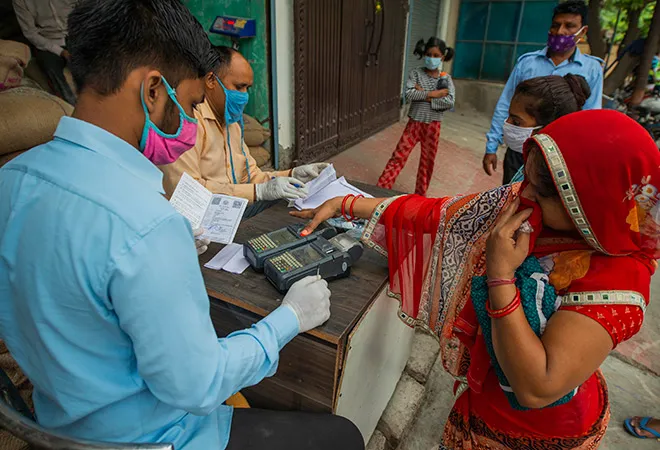
The COVID-19 pandemic has supposedly put a halt to the last three decades of high growth that India has witnessed since liberalisation. Although, as per the recent figures, the second wave seems to be receding, the effect it has had on the rural areas has been staggering owing to the lack of inclusive development in many districts across the country. The inequity in development and the urban-rural divide in the country has also been constantly evident in India’s dismal Human Development Index (HDI) rankings in the recent times. It ranked 131 amongst 180 countries, according to the annual United Nations Development Programme (UNDP) report.
For a country as diverse as India, it is very difficult to have an all-sharing growth model without proper policy interventions that can reach the grassroots. The government, therefore, has been constantly trying to come up with innovative policies that have a larger impact on societies as a whole. Of many envisioned programmes, very few have managed to strike the right chord and make a tangible difference in the lives of people. One such programme has been the Aspirational District Programme launched by the government in January 2018, in an attempt to push for substantial growth across various socio-economic parameters in areas that still remain distant from inclusive development. The programme is amongst one of the very few initiatives of the government that has made significant impact in a short period of time garnering praise from various international and national agencies that focus on development.
The government has been constantly trying to come up with innovative policies that have a larger impact on societies as a whole. Of many envisioned programmes, very few have managed to strike the right chord and make a tangible difference in the lives of people
The initiative started as an outcome-focused governance programme by the Government of India across 117 backward districts to expeditiously improve the socio-economic status of these areas and bring them to the forefront. Based on three core principles of convergence, collaboration, and competition amongst various stakeholders involved, the unique programme aimed to track and measure the growth of the districts under it on 49 developmental indicators, ranging broadly across five themes namely, health and nutrition, agriculture, financial inclusion and skill development, basic infrastructure, and poverty.
What sets it apart?
The uniqueness of this programme lies in the fact that it is one of the very few programmes initiated by the government that quantifies progress in development through real time data collection in regular periodic intervals to evaluate the status of progress. The core of the programme lies in the philosophy of “What gets measured gets managed”, and, therefore, the focus is on having set parameters to measure real-time progress on the ground. Secondly, this is one of the programmes that brings together various stakeholders right from central level to the panchayat level, with a very clearly defined comprehensive framework that has clearly demarcated the roles of each stakeholder, enabling everyone to focus their efforts towards achieving the targets of the programme. The delta ranking devised by the NITI Aayog to measure and track the progress is also one of the unique features of the ADP. The focus for rankings shifts from absolute growth in numbers to percentage change in improvement, which allows a level playing ground for relatively backward districts to compete. The programme is a unique model that showcases competitive and co-operative federalism in the best spirits.
The delta ranking devised by the NITI Aayog to measure and track the progress is also one of the unique features of the ADP. The focus for rankings shifts from absolute growth in numbers to percentage change in improvement, which allows a level playing ground for relatively backward districts to compete. The programme is a unique model that showcases competitive and co-operative federalism in the best spirits.
Impact
The impact of the ADP across the implemented districts has been quite inspiring. Concerted efforts by various stakeholders, from government organisations to NGOs and the public as well, have led the districts under the ADP to experience more growth in the last three years than ever before. The difference-in-difference analysis used in a recent UNDP report to study the impact of the programme have also indicated that the aspirational districts have clearly outperformed non-aspirational districts in developmental parameters. The reasons could be varied, ranging from the political salience the programme brought with itself, more vigilance from the government, a comprehensive framework, and competitive pressure to perform well in the rankings to the support provided by different stakeholders engaged in the programme. All these factors had a role to play. Anecdotal evidence such as reduction in malaria cases in the Bastar region of Chhattisgarh; improvement in nutrition outcomes through continuous monitoring in the Poshan app in Ranchi, promoting local products through e-commerce in Goalpara district of Assam; and improving irrigation facilities through recharge pits in Washin, Maharastra are all success stories that were a part of the ADP in these backward districts. Some amongst these practices have been very efficient in realising its goals leading many other districts to implement them.
What changes can the programme embrace in the future
Though the Aspirational District Programme has been very successful, there still remains significant scope for improvement in the future. The programme should now embrace other themes into its fold, apart from the existing five broad themes. Secondly, the issue of disparities amongst districts do not facilitate fair competition and should be addressed. Further, as ADP has a competitive aspect to it that goes by the ranking system, there have been serious concerns of discrepancies in data collected and data recorded. Therefore, there lies a serious need for a newer methodology of evaluation that can stop the misreporting of data. Lastly, for the ADP to become a mass movement and reach a larger section of society in the country, the government should focus on improved capacity building exercises, fund allocation, and technical expertise at the block level. These few areas are the only areas left to be addressed in an otherwise brilliant programme.
For the ADP to become a mass movement and reach a larger section of society in the country, the government should focus on improved capacity building exercises, fund allocation, and technical expertise at the block level. These few areas are the only areas left to be addressed in an otherwise brilliant programme.
Conclusion
As per the recent appraisal report of the UNDP, the aspirational district programme has had a very positive impact on the districts where it was implemented. However, the programme was initially envisioned as a policy initiative to improve India’s rank in the Global Human Development Index, which clearly doesn’t seem to have served its purpose as India still ranks as low as 131. What is urgently needed is a few indicators that had seemed to be saturated (like electrification of households as a measure of basic infrastructure); they should be revised and re-designed. There are also instances from districts like Yadgir (Karnataka) where the least improved districts have seen further increase in vulnerabilities. These districts require more attention and a special focus. Lastly, as the programme is already three years old, the momentum and motivation amongst stakeholders since its inception has evidently reduced, which requires governmental intervention to again motivate them through various re-training and learning programmes. The ADP is definitely one of the governmental initiatives that has been able to make a mark in the lives of people living in the remotest parts of India. Therefore, given the positive impact of the programme, it is very important to ensure every stakeholder in the ADP is encouraged further and the momentum is sustained. The best practices of the programme can also be replicated in other districts in the future.
The views expressed above belong to the author(s). ORF research and analyses now available on Telegram! Click here to access our curated content — blogs, longforms and interviews.




 PREV
PREV


